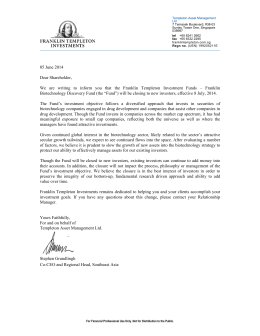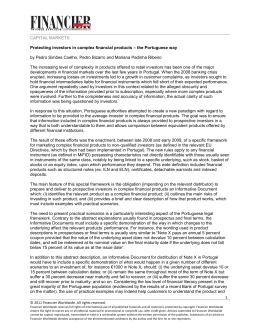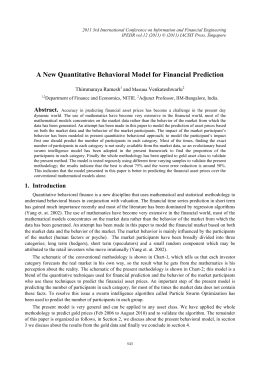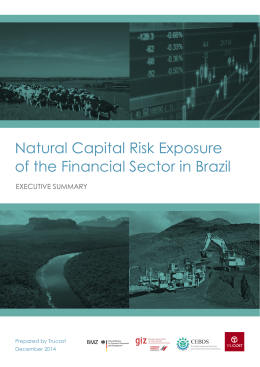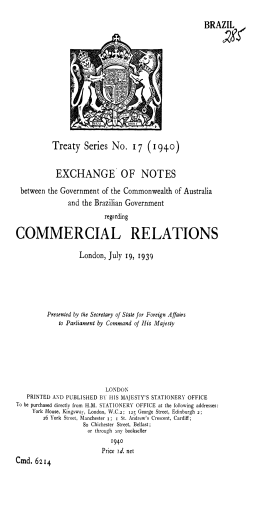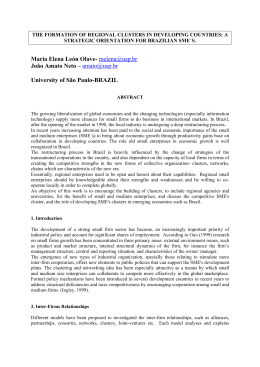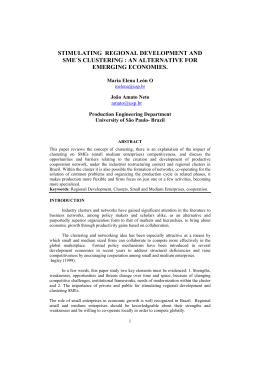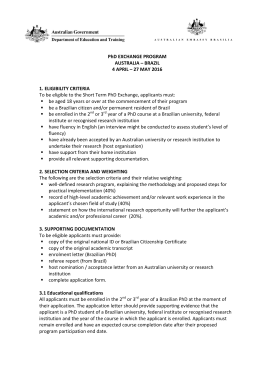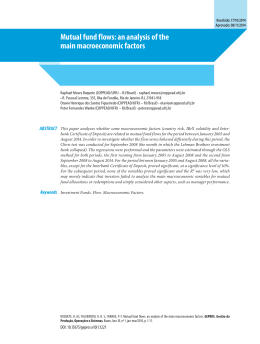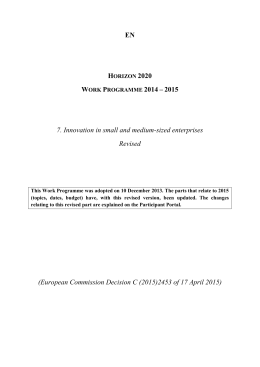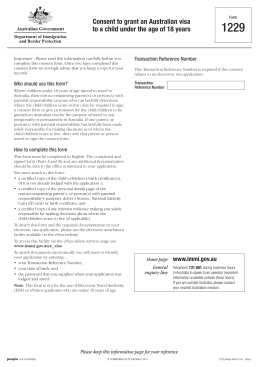Equity Financing SME´s through Capital Market WORKING GROUP REPORT INTERNATIONAL EXPERIENCE Equity Financing SME´s through Capital Market Working Group Members ABDI Cassio Rabello BNDES Bruno Caldas Aranha BM&FBOVESPA Cristiana Pereira Edna Holanda Helen Yao (China office) Lucy Pamboukdjian Renato Issatugo Sérgio Gullo (London office) CVM Paula Sarno Wang Jiang Horng FINEP Augusto F. da Costa Neto Hudson Lima 2 Equity Financing SME´s through Capital Market CONTENT INTRODUCTION SECTION I – ISSUERS a) Are there significant differences in listing rules between the main and alternative markets? b) Are listed companies subject to disclosure and governance requirements? c) Are there any similarities between issuers that have held IPOs? d) Are there registration exemptions for securities offerings, facilitating IPOs? e) Can we consider that costs directly linked to the IPO process tend to discourage issuers to move on with it? f) Are there any mechanisms to mitigate cost uncertainty in the event of an IPO failure? g) Are there any mechanisms to mitigate pre-flotation uncertainty from the issuer’s standpoint? h) Is it difficult to find brokers and distributors? i) Are there tax or other incentives for companies that plan to access the capital markets? SECTION II – INVESTORS a) Who are the investors? b) How do investors deal with low liquidity in the secondary market? Are there mechanisms to boost liquidity? c) How do investors deal with the risks inherent in SMEs? d) What is the rationale for investing in SMEs? e) Are there any tax incentives or other benefits for investors? SECTION III – INTERMEDIARIES, THE LINK BETWEEN ISSUERS AND INVESTORS a) Who operates the offering distribution? b) Do intermediaries fear the risks associated with the companies they introduce to the market? What are their liabilities? c) How do intermediaries’ channels operate, i.e. how do they reach out to investors? d) What is the economic rationale for intermediaries in smaller offerings? 4 8 9 10 11 12 15 16 17 17 18 18 19 20 20 22 22 23 24 3 Equity Financing SME´s through Capital Market INTRODUCTION 1. The working group comprised representatives of ABDI, the Brazilian Industrial Development Agency; BNDES, the National Development Bank; BM&FBOVESPA, the Securities, Commodities and Futures Exchange; CVM, the Securities and Exchange Commission; and FINEP, the Federal Innovation Agency. Seven countries have been visited – Australia, Canada, China, Poland, South Korea, Spain and the United Kingdom – to find out about alternative stock market rules and practices, success stories, and relevant experiences in these trading environments tailored to the capital-raising needs of small and medium enterprises. In addition, where possible and to the extent permitted by the time available, the working group also endeavored to explore the practices prevailing in the main markets of these countries, since many of them also list a large number of SMEs.1 2. Different models were identified, varying substantially in terms of company size and characteristics (core business), regulatory and self-regulatory frameworks, and investor and intermediary profiles. Country UK Canada Spain Poland South Korea China2 Alternative Market Alternative Investment Market (AIM) Established in 1995 1,114 listed companies (Jun/12) Toronto Stock Exchange Venture (TSXV) Established in 1997 2,277 listed companies (May/12) Mercado Alternativo Bursátil (MAB) Established in 2008 21 listed companies (May/12) New Connect (NC) Established in 2007 397 listed companies (Jun/12) KOSDAQ Established in 1987 785 listed companies (Jun/12) Chinext Established in 2009 332 listed companies (Jun/12) Main Market London Stock Exchange (LSE) Established in 1698 1,372 listed companies (Mar/12) Toronto Stock Exchange (TSX) Established in 1861 1,577 listed companies (May/12) Bolsas y Mercados Españoles (BME) Established in 1831 130 listed companies (Dec/11) Warsaw Stock Exchange (WSE) Established in 1991 434 listed companies (Jun/12) KOSPI Established in 1956 1,031 listed companies (Jun/12) SME Board Established in 2004 683 listed companies (Jun/12) 1 SMEs are defined in the present report as having market cap of less than US$250 million and IPOs of less than US$150 million. 2 China has two exchanges, Shanghai Stock Exchange (SSE) and Shenzhen Stock Exchange (SZSE). As a rule the largest Chinese companies are listed on SSE while SMEs are listed on SZSE. Chinext and SME Board are both part of SZSE. In this report Chinext is considered the alternative market and SME Board the main market unless otherwise specified. 4 Equity Financing SME´s through Capital Market Country Australia Alternative Market Main Market Australian Securities Exchange (ASX) Established in 2006 as a merger of Australian Stock Exchange3 and Sydney Futures Exchange 2,211 listed companies (Jun/12) 3. Start-ups and greenfield companies predominate on the alternative markets in Canada (TSXV) and Poland (New Connect), where IPO ticket sizes are very low. For example, 53% and 62% of the companies listed on TSXV (Canada) and NC (Poland) respectively have market caps of less than US$5 million. 4. TSXV (Canada) and NC (Poland) offer a higher “regulatory discount”, if compared to the other visited markets, in order to facilitate access to the capital market for smaller companies. It was considered that the cost of regulatory requirements would be a heavier burden for these companies than for large caps. 5. However, there is a distinction between the two markets: greenfield mining and oil & gas companies predominate on TSXV (Canada), whereas NC (Poland) is more diversified thanks to the presence of start-ups and SMEs that would be considered micro-firms in Brazil. 6. It is important to note that capital markets regulators do not oversee companies that trade on alternative markets in the UK (AIM), Spain (MAB) and Poland (NC), in accordance with prerogatives granted under EU directives. In these cases the model implemented has resulted in a private arrangement whereby regulatory supervision is replaced by advisors (Nominated Advisors or Nomads in the UK, Asesores Registrados in Spain and Authorized Advisors in Poland). To a certain extent the model is intended to rely on these agents’ reputations. There are doubts about their effectiveness, given the difficulty of enforcement. 7. We were particularly surprised by the gap between AIM (UK) and both TSXV (Canada) and NC (Poland) in terms of the maturity and size of their listed companies: 38% of the companies listed on AIM have market caps in the range of US$16 million-US$80 million, while another 24% are worth more than US$80 million.4 8. Furthermore, although in the UK the rules for admission to AIM are more flexible than the rules for admission to the LSE’s main market, AIM does not offer a 3 The Australian Stock Exchange was established in 1987 as a merger of seven regional exchanges. Australia’s first exchange was set up in 1861. The Sydney Futures Exchange was founded in 1960. 4 British pounds translated into US dollars at the exchange rate in force on Oct. 1, 2012. 5 Equity Financing SME´s through Capital Market significant regulatory discount as far as disclosure requirements are concerned compared with those of the main market’s Standard segment.5 Even when issuers choose the IPO route that exempts them from registering the offer with the regulator (which the vast majority do choose), the amount of information required in the listing document is similar to a prospectus. Finally, in contrast with TSXV (Canada) and NC (Poland), where the presence of individual investors is very strong, institutional investors predominate in the case of AIM (UK). 9. At the opposite extreme of the alternative market spectrum are the Asian markets Chinext (China) and KOSDAQ (South Korea), which are larger than their Western peers, especially in the case of Chinext. Over half the companies listed on Chinext (51%) have market caps of more than US$300 million, while 46% of the companies listed on KOSDAQ are worth more than US$50 million. Of all the IPOs held on Chinext between 2010 and June 2012, 48% were worth between US$50 million and US$100 million, while 34% exceeded US$100 million. In the case of KOSDAQ, 56% of IPOs in the same period exceeded US$40 million. It should be stressed that the Chinese regulator decides which market a company should list on and that South Korea’s alternative market focuses on technology companies. 10. Disclosure requirements for the main and alternative markets in China and South Korea are basically the same. In fact, their alternative markets have some rules that do not apply to their main markets. 11. Australia has no alternative market. Greenfield projects, SMEs and large caps all raise capital in one and the same market. ASX has approximately 2,000 listed companies, and two-thirds of the 200 IPOs that took place between 2010 and 2011 were by greenfield companies (raising less than US$10 million, with 80% raising less than US$5 million). Moreover, 24% of these IPOs were worth between US$10 million and US$50 million. 12. As we analyze these experiences, one of the main implications is probably that we should think about what our focus or priority should be at this time. In all analyzed markets, it is clear that many SMEs do use the capital markets to raise funds. Given the conditions prevailing in Brazil today, it may be more appropriate to focus in the short run on building a viable alternative for SMEs to raise funds in the capital markets while leaving greenfield projects and start-ups until later. 5 The UK’s main market has two segments, Standard and Premium, corresponding roughly to the “Tradicional” and “Novo Mercado” segments respectively in Brazil. 6 Equity Financing SME´s through Capital Market 13. A second implication is the perception that the functioning of other markets is strongly based on market practices: alignment of interests to reduce investor risk perceptions; a network of intermediaries that reaches out to investors; and a culture of investment and risk. 14. However, this does not mean the public sector cannot make a relevant contribution to the development of the capital markets as a source of funding for SMEs in Brazil. For example, in some of the countries visited we found that: (i) specific tax incentives are in place for investors in SMEs; (ii) the creation of specific investment vehicles for this market is fostered; (iii) specific rules are in place to facilitate access to the capital markets by SMEs, including disclosure rules; and (iv) SMEs are offered financial assistance to cover the expenses associated with the pre-listing process. 15. Regardless of the alternative market model implemented, the working group expects some of the mechanisms observed to serve as useful inputs to the debate here in Brazil and provide ideas on the ways in which we might format our market for SMEs. The following report is divided into three sections in question-and-answer form, what provides an easier reading and understanding experience. The first section focuses on issuers, the second on investors and the third on intermediaries, as the bridge between the first two. 7 Equity Financing SME´s through Capital Market SECTION I – ISSUERS a) Are there significant differences in listing rules between the main and alternative markets? 16. In most countries listing requirements can be appointed as one of the essential differences between the main market and the alternative one. These rules are basically quantitative and include minimum free float, ownership dispersion (minimum number of shares issued and shareholders), profitability, company history (including the number of audited financial statements), size and capitalization. 17. In some countries, such as Canada, both the main and alternative markets adopt qualitative listing rules that vary depending on the economic sector to which an applicant belongs but are much stricter in the main market than in the alternative market. These rules cover such items as finance and working capital, property, business plan and technical opinions. 18. In general, it seems that the rules adopted in the main market tend to restrict market access, so that listed companies on this market are known for having a longer history and for being mostly more liquid. Some examples (not exhaustive for each market): UK – The main market requires minimum free float while AIM does not. Spain – The main market requires a history of profitability while MAB does not. Canada – The main market requires minimum capitalization while TSXV does not; in addition, the main market requires a minimum shareholder base and a larger number of shares issued than TSXV (while on the other hand only TSXV requires minimum free float). Poland – The main market requires minimum capitalization and free float while NC does not. China – SME Board requires higher levels of earnings and sales while for Chinext the test requirements are lower. South Korea – The main market has higher cutoff values for net worth and capitalization. Australia – Also has criteria of this kind for admission to trading. 8 Equity Financing SME´s through Capital Market b) Are listed companies subject to disclosure and governance requirements? 19. Yes, in both the main and alternative markets. However, in some alternative markets there are significant discounts compared with the main market. 20. The most relevant differences were found in the alternative markets that focus on very small firms or start-ups (strong concentration in IPOs below US$5 million), such as TXSV (average ticket size of US$2 million)6 and NC (average ticket size of US$1 million). TSXV (Canada) exempts annual information forms (similar to Form 20F)7, exempts auditing of quarterly financial statements, grants more time for the filing of annual and quarterly financial statements, requires only a simplified governance form, and restricts market disclosure requirements to highly significant transactions. NC (Poland) exempts semiannual financial statements and semiannual reports, replaces quarterly financial statements with a report on selected items, grants extended time to deliver periodical information, and requires a simplified “Comply or Explain” governance list. TSXV (Canada) and NC (Poland) allow the issuance of preferred shares (with distinct rights) but issuers in general are limited to issuing common stock. 21. In alternative markets with IPOs worth more than US$5 million by SMEs, the disclosure requirements differ less than those for the main market. It should be noted that in this group, with the sole exception of Spain, the main market has a substantial group of companies of the same size as in the alternative market. The outstanding examples are the UK, China and South Korea. In the UK, unlike the main market, AIM does not require companies to file a specific governance report and exempts the quarterly interim management statement (IMS). In China and South Korea, the requirements for the main and alternative markets are practically identical. In some cases the alternative market appears to be more “rigorous” in its requirements. For example, companies listed on Chinext must invest the funds raised in their core business or other specified destinations, while KOSDAQ requires permanent internal auditing for 6 The exchange rate used to translate both the Canadian dollar and the Australian dollar into USD dollars was close to 1:1. 7 Form 20-F is an annual filing required by the US Securities & Exchange Commission (SEC) for certain foreign companies to disclose information considered relevant to the US market. 9 Equity Financing SME´s through Capital Market companies with total assets in excess of US$90 million; the main market does not have this requirement. In Australia, where there is no separate market for SMEs, the rules are precisely the same. 22. The following observations are pertinent to main markets as a general rule: They require semiannual but not quarterly financial statements, as well as annual and/or semiannual reports containing information limited mainly to financial statements, explanatory notes and a management commentary, except in Canada, where the annual information form (AIF) is similar to Form 20F. Disclosure on governance, compensation and related-party transactions is required in some jurisdictions. Only voting shares may be issued in most cases. No countries except China and South Korea require publication of financial statements and other information in major daily newspapers or the official gazette (for both the main and alternative markets). All market disclosure is via electronic means. c) Are there any similarities between issuers that have held IPOs? 23. In certain markets we observed specific features of very small companies that held IPOs in terms of sector and maturity: In the case of TSXV (Canada), where the average IPO is worth US$2 million, most companies belong to the mining and oil & gas sectors, with greenfield projects accounting for a high proportion. In the case of ASX (Australia), two-thirds of IPOs are worth between US$2 million and US$5 million. Most companies are from the mining sector, with greenfield projects accounting for a high proportion. In the case of NC (Poland), where IPOs average US$1 million, the companies concerned are in various sectors but can be divided into start-ups and more mature SMEs. 24. For companies in other markets no common features were identified. In the case of Chinext, where everything is superlative, over 80% of IPOs raised more than US$50 million and over half the companies listed have market cap in excess of 10 Equity Financing SME´s through Capital Market US$300 million. In the case of KOSDAQ, which is tech-heavy, 66% of IPOs raised more than US$40 million and 22% of the companies listed have market caps in excess of US$100 million. d) Are there registration exemptions for securities offerings, facilitating IPOs? 25 In some visited markets - UK, Spain, Canada, Poland and Australia – there is a registration exemption system (and hence the prospectus) for offerings with the following characteristics: Below a specified amount (€5 million in Europe and AS$2 million in Australia); or Targeted to certain groups, such as institutional investors, investors with minimum amounts of net worth or income, persons close to the controlling shareholder or management, such as friends, relatives etc; or Targeted to a limited number of investors (100-150) including “ordinary” individuals. 26. In the UK, Spain, Canada and Poland, companies listed on alternative markets mostly use registration exemptions. This was the case for some 90% of IPOs on AIM in recent years in terms of the capital raised, practically 100% on Poland’s NC, and about 70% on Canada’s TSXV (IPOs and follow-ons). In some jurisdictions, such as Canada, shares bought in IPOs cannot be sold during a lock-up period (of four months, for example), and information must be filed with the regulator within a certain time limit after the offering. 27. TSXV (Canada) has another much-utilized mechanism known as a Capital Pool Company (CPC), for which registration is not waived. A CPC is defined as a program and requires specific registration with the regulator. Legally speaking it is a holding company founded by individuals of high standing in business and the capital markets. A CPC can raise up to C$4.75 million in an IPO, using the proceeds to identify an appropriate business within two years as its “qualifying transaction”. TSXV reviews the qualifying transaction to ensure it meets minimum listing requirements, and a private placement is then typically held to fund the resulting company. 28. In the main markets, SMEs and other companies have opted to register IPOs even where an exemption applies. 11 Equity Financing SME´s through Capital Market e) Can we consider that costs directly linked to the IPO process tend to discourage issuers to move on with it? 29. In several of the countries visited the number of IPOs fell sharply after 2007 and particularly in the past two years. This is true for both main and alternative markets, although there are still far more IPOs there than in Brazil. However, the direct cost of an IPO does not appear to be the main obstacle to raising funds in the capital markets. According to interviews, the main obstacle is rising risk aversion on the part of investors, who have preferred other options. 30. Based on the information that direct cost is not an inhibitor in these markets, the working group sought to compare the fixed expenses incurred by issuers in some of the countries visited (Poland, Canada, the UK and Australia, where a minimum of data could be obtained) with the expenses incurred by Brazilian issuers. 31. The working group analyzed fixed cost because there is a belief that in Brazil fixed cost may be one of the main inhibiting factors. Its importance lies largely in the fact that a company has to disburse these expenses whether or not it actually succeed in holding an offering, unlike the fees paid to intermediaries, for example. Fixed cost includes payments to service providers to help prepare the company and documentation for the IPO and listing. 32. No comparisons of intermediaries’ fees (termed variable cost in this report) were made because these differ considerably in accordance with business conditions. However, the applicable fees in some of the countries visited are mentioned to provide at least a frame of reference. 33. It is important to interpret this comparison with caution. The various alternative markets examined have differing business models, for one thing. Moreover, our review of the prospectuses or listing documents for Canada and the UK was based on a limited number of IPOs held in 2011. There are also differences among the countries in terms of purchasing power parity. 34. Despite these limitations, however, given the debates about this subject the working group decided that it would be highly productive to address it in the report at greater length (in contrast with the conciseness of the rest of this report) and provide some indications that can be explored in depth at a future opportunity. Two other types of expense can also be explored in future: (i) the implicit cost of an IPO, i.e. the time invested by the company’s employees and 12 Equity Financing SME´s through Capital Market executives, as well as opportunity cost; and (ii) the cost of maintaining a listing, for which the working group was unable to obtain consistent data. 35. The Brazilian data used in the comparison relate to IPOs worth US$75 millionUS$120 million (at the exchange rate in force in Oct. 11 – Renova Energia, Direcional Engenharia, Le Lis Blanc, Helbor and Banco Indusval), for which the average fixed cost was 1.98%, with variable cost (brokerage commission) of 3.31%. Our findings for the countries visited are as follows: Canada – In a sample of IPOs registered and held in 2011 on TSXV, it was found that the fixed cost of offerings worth between US$500,000 and US$3 million (the average value of an IPO on TSXV is US$2 million) ranged from US$25,000 to US$140,000, or 7.22% on average. In the main market, the fixed cost of IPOs worth between US$20 million and US$25 million averaged 3.57%, while the fixed cost of IPOs worth US$65 million-US$150 million averaged 2.36%. In the case of the alternative market (TSXV), it should be stressed that we may have underestimated fixed cost, as service providers were remunerated in the form of stock or warrants in several instances (stock options are regularly awarded to intermediaries). On the other hand, fixed cost may be lower for IPOs involving Capital Pool Company (CPC) programs. Furthermore, the low absolute value appears to be possible only because the issuers concerned are mostly greenfield projects, as is also the case for a significant proportion in Australia. Finally, fixed cost appears to be slightly higher than in Brazil (2.36% vs. 1.98%), and it is quite likely that Canadian issuers of this size also undertake sales efforts in the United States. UK – AIM may be the alternative market best suited to this kind of comparison, since: (a) we were able to obtain data on IPOs exempt from the registration requirement (the most frequent type in the case of IPOs held on AIM), enabling us to estimate the savings made possible by such exemptions; (b) this market is not concentrated in IPOs by micro-firms and a wide cross-section of sectors is represented. An analysis of 17 listing documents showed that the fixed cost of IPOs worth US$1 million-US$6 million averaged about 12%, much higher than in Canada, while that of IPOs worth US$64 million-US$120 million averaged 3.6%, almost twice as much as in Brazil (with brokerage commissions, i.e. variable cost, ranging from 3.5% to 5%). One hypothesis to explain the higher cost on AIM (UK) may relate to expenses incurred with Nomads, although this needs to be validated. Because issuers listed on AIM (UK) are not regulated or supervised by the Financial Services Authority (FSA) and its IPOs are not registered, Nomads (like Authorized 13 Equity Financing SME´s through Capital Market Advisors in the case of Poland’s NC) are responsible for preparing issuers for IPOs, assisting them throughout the process and supervising compliance after an IPO to give investors some comfort, albeit without enforcement powers. The perception is that exemption from registration has not lowered IPO costs in the UK (although it has speeded up the process). Australia – As noted earlier, Australia does not have a segregated alternative market. The Australian market can be basically defined as a sum of Canada’s TSX main market and TSXV alternative market. Out of almost 200 IPOs held by companies listed on ASX in 2010 and 2011, small IPOs by greenfield projects, mainly in mining, accounted for a significant proportion (two-thirds), and in this respect the Australian exchange is comparable to Canada’s alternative market (TSXV). The other third of the IPOs held on ASX in the period were in a somewhat higher range (US$10 million-US$100 million). It is important to note that Australian companies have opted for registered IPOs even where exemption was available. In practice the prospectuses appear to be simpler than in Brazil. The source for the data used in this case is a survey by ASX.8 Fixed and variable cost could not be separated because the prospectuses do not provide a breakdown of these expenses. However, some interviewees said brokerage commissions are about 5% for IPOs worth up to US$100 million. Assuming 5%, therefore, we have a median fixed cost of about 4.5% for mining IPOs (for example, for IPOs worth US$2 million, which are very common, fixed cost would be some US$90,000). The fairly low amount in absolute terms may reflect the fact that this type of issuer demands little work. For IPOs worth US$50 million-US$100 million, median fixed cost would be about 2.2%, very close to the Brazilian equivalent, which is 1.98%. In the latter case, the simplicity of the prospectuses, which is typical in Australia, does not appear to contribute to a reduction in expenses with advisors but does appear to have speeded up the IPO process. Poland – On Poland’s alternative market (NC) the average value of an IPO is about US$1 million (only 18 out of 217 IPOS held between 2009 and 2011 were worth more than US$2 million, and several raised only a few tens of thousands of dollars). An IPO in this value range costs about 4.3% (US$43,000)9 including the fees paid to intermediaries (which in some cases include stock options, not 8 9 IPO: the Road to Growth and Opportunity, ASX. Material kindly made available by the Warsaw Stock Exchange (WSE). 14 Equity Financing SME´s through Capital Market covered by this estimate). In the main market, the total cost of IPOs worth US$65 million-US$130 million averages 2.06%.10 The first impression is that the low amounts for both the main market and the alternative market probably reflect peculiarities of Poland’s market participants, since total cost is much less than for other markets about which we obtained information. A second impression is that based on total cost for the alternative market in absolute terms the process of preparing companies, IPOs and listing is probably very simple, which is possible only because this is a market for start-ups and micro-firms. 36. In sum, fixed cost is higher in most of these cases than in Brazil, or at least very similar. This initial analysis, therefore, does not seem to point to lower fixed cost as a key advantage in the functioning and development of these markets, although in some cases speed of market access may be the significant factor. It also remains to be verified whether additional factors, such as the obligation to engage a Nomad, could incur additional expenses that do not exist in Brazil. Market IPO size Fixed cost as % of IPO Brazil US$75 mm – US$120 mm 1.98% (average) Canada (main – TSX) US$65 mm – US$ 150 mm 2.36% (average) UK (alternative – AIM) US$64 mm – US$120 mm 3.6% (average) Australia US$50 mm – US$100 mm 2.2% (median) Poland (main – WSE) US$65 mm – US$130 mm 2.06 % (total cost)11 f) Are there any mechanisms to mitigate cost uncertainty in the event of an IPO failure? 37. Although fixed cost was not considered a barrier in the visited markets, it may become relevant if the issuer is not completely confident about its IPO success, since the cost will have to be paid even in the event of failure or cancellation. The amounts involved could therefore be a barrier, especially for SMEs, which may not have enough cash flow to bear the extra expense. 10 11 Listing on the Warsaw Stock Exchange, PWC. Underwriting guarantees were not included in the survey. Underwriting fees, if any, were not included in the survey. 15 Equity Financing SME´s through Capital Market 38. With regard to fixed cost, in the UK (AIM) there were reports of the existence of arrangements with advisors or consultants based on the success of an IPO. , These arrangements would mitigate failure to a certain extent. We also found that part of fixed cost is paid in stock and warrants in some IPOs held on Canada’s alternative market (TSXV). 39. In addition, frequent use offerings registration exemptions on Canada’s and the UK’s alternative markets gives them flexibility in prospecting for investors. Thus the success of an offering or its failure to achieve the desired price can be anticipated to some extent, minimizing expenses for those who prefer to cancel. Even in Australia, where the majority of IPOs are registered, investors may be approached before a prospectus is filed and in practice the prospectus is filed only if and when the IPO has been sold. This reduces the fixed cost associated with registration, listing and related items (which is by no means negligible) in the event of cancellation. g) Are there any mechanisms to mitigate pre-flotation uncertainty from the issuer’s standpoint? 40. No mechanisms to mitigate pre-IPO uncertainty, such as firm commitment, were identified (it was identified best efforts commitment). However, shorter lead times for IPOs could reduce the uncertainty inherent in the process by reducing exposure to the risk of changes in market conditions. 41. In Australia and Canada, the lead time for IPOs is relatively short, 5-6 months, and for projects (companies that are not yet operating) the lag between setting up the firm and receiving funds may be as short as 3 months. 42. In addition, one of the main reasons for which offerings with exemption from registration are currently the main option for companies in the alternative market in the UK is the speed of this process, which is shortened by not having to register ex ante with the regulator and not having to prepare a prospectus (although the admission document required by AIM resembles a prospectus). 43. To sum up, some countries do appear to offer certainty about investor demand, as noted in the previous section, in conjunction with shorter IPO lead times. 16 Equity Financing SME´s through Capital Market h) Is it difficult to find brokers and distributors? 44. Judging by the opinion of our interviewees, this is not difficult under normal market conditions. However, some of them said that difficulties are on the buyside due to the current perception of high investor risk. 45. It is important to note that in some of the markets visited there are brokers who specialize in SMEs (see section on intermediaries below). i) Are there tax or other incentives for companies that plan to access the capital markets? 46. Spain has regional incentives such as grants to cover the cost of preparing an IPO. No direct incentives linked to market access were found in the other countries visited. 47. Generally speaking, the tax incentives identified in the countries visited are targeted at retail and institutional investors who buy shares in companies listed on the alternative markets, either directly or via specific investment vehicles (see section on investors below). 17 Equity Financing SME´s through Capital Market SECTION II – INVESTORS a) Who are the investors? 48. The working group found that participation by different types of investors depends closely on the size of the offering: Considering the three markets for which we obtained data (the UK, Canada and Australia), foreign investors are more interested in IPOs with offers above a certain threshold – US$80 million for the UK, US$50 million for Canada, and US$200 million-US$250 million for Australia. The participation of local institutional investors varies from country to country. In Canada (TSXV), for example, they can account for as much as 60% even in smaller IPOs. In Australia, local institutional investors account for a far higher proportion in IPOs worth more than US$100 million, although they may participate in some smaller IPOs (US$25 million-US$30 million). Individual investors are always important in SMEs offerings. For example, for IPOs on KOSPI (averaging US$142 million) and KOSDAQ (averaging US$71 million) this category’ participation reaches 40%; in the case of very small IPOs, which are typical for NC (Poland) and some offerings in Australia, most investors are “ordinary” individuals – in the specific case of Australia, according to our interviewees, they are local people who are familiar with the projects and the risks of greenfield investment, while in the UK the individuals who participate in smaller IPOs on AIM are mainly high net worth investors or wealthy individuals who invest directly or via funds that are specialized in SMEs. b) How do investors deal with low liquidity in the secondary market? Are there mechanisms to boost liquidity? 49. Two mechanisms are widely utilized: listing rules focused on dispersion, such as some share issuance requirements, minimum number of shareholders and also minimum free float (Canada, Australia and Shenzhen), and the obligation to involve a market maker (MAB in Spain, and NC in Poland ). In Canada, although engaging a market maker is not mandatory, it is the practice in the alternative market. However, even with these mechanisms in place liquidity is generally low for shares in SMEs in the secondary market. 18 Equity Financing SME´s through Capital Market 50. With rare exceptions, we were unable to talk to investors directly. Some other interviewees reported that there is some liquidity where there is some dispersion. They also said that although liquidity is a concern, SMEs investors are far more interested in returns than in short-term liquidity, since they know this will come only with the company’s development. For this reason, investors who are concerned about immediate liquidity tend to not invest in SMEs. c) How do investors deal with the risks inherent in SMEs? 51. The answer to this question varies from one market to another, mainly involving cultural differences, regulation or self-regulation, and market practices. 52. In the case of mining companies (especially the greenfield projects common on TSXV and the Australian market), investors appear to be culturally accustomed to this type of investment, and are aware of the risk and familiar with the sector. In addition, there is a specific regulatory framework for the sector, with disclosure rules and certification of reserves by accredited professionals. Although there is a high failure rate, as is only to be expected for this type of venture, we heard no reports of complaints on this subject. Indeed, we found in Canada that prospectuses for greenfield projects begin with a prominent warning about the highly speculative nature of the investment. 53. In China’s and Korea’s alternative markets, Chinext and KOSDAQ, issuers and their management and/or controlling shareholders are apparently subject to a number of strict rules designed to discourage IPOs with a high probability of failure. On KOSDAQ, for example, the majority shareholder in a company whose registration is cancelled ex officio by the exchange cannot apply to list other companies. In the case of Chinext, prospectuses must contain a disclaimer emphasizing the additional riskiness of this type of offering. 54. In the case of European alternative markets (AIM, NC and MAB), which are not under the supervision and enforcement power of regulators , there is the figure of the Authorized Associate (NOMAD, Authorized Adviser and Asesor Registrado respectively). These advisors act as gatekeepers and investors believe and count on their reputation. 55. The role of Nomads and similar advisors is to bring investors to market and supervise the conduct of issuers once they have listed. 19 Equity Financing SME´s through Capital Market Problems with advisors were reported in the UK and Poland. It was pointed lack of due diligence with regard to the quality and growth potential of the companies they introduce to the market, supervise and/or assist, possibly owing to conflicts of interest, as they are engaged and paid by the companies they advise. Weak enforcement on issuers and the confusing nature of advisors’ responsibilities in deregulated markets have given rise to considerable debate. 56. A market mechanism found in Canada, Poland, Australia and to a lesser extent the UK involves payment of intermediaries or advisors in options, warrants and/or stock. There are different formats with regard to exercise price and lock-up (typically at least two years). 57. The aim of this remuneration mechanism is to align interests. From the issuer’s standpoint it encourages the intermediary or advisor to continue taking an interest in the company after the IPO. From the investor’s perspective, the fact that part of the intermediary’s remuneration is linked to the company’s future performance can be considered an indication of this professional’s assessment of its quality and growth potential. Finally, for the intermediary the mechanism offers an opportunity for earnings, although this may be seen as a cause for concern with regard to possible conflicts of interest if and when an intermediary sells stock in follow-up offerings by the same issuer. d) What is the rationale for investing in SMEs? 58. Investment in SMEs follows a different rationale from investing in the stock of large caps. As pointed out earlier, investors who focus on immediate liquidity have no incentive to invest in SMEs. Nor do investors who focus on dividend payout. 59. Generally speaking, according to the interviewees, investors in SMEs are interested in potentially higher returns deriving from stronger growth despite the higher risk. e) Are there any tax incentives or other benefits for investors? 60. Four of the seven countries visited – the UK (AIM), Canada (TSXV), China (Shenzhen/Chinext) and Korea (KOSDAQ) – have tax incentives for investors, whether they are individuals or corporates. These tax incentives include: Full or partial deduction of the invested amount from the investor’s tax base or income tax liability; 20 Equity Financing SME´s through Capital Market Exemption of capital gains tax on the proceeds from sales of stock in listed companies; Reinvestment of capital gains in listed companies; Exemption from tax on dividends; Exemption from inheritance or estate tax on stock; Lock-up restrictions are common (requiring investors to retain ownership of stock for a certain period). 61. In Canada, mining and oil & gas companies can issue flow-through shares to pass tax incentives on to shareholders in exchange for developing natural resources provided they list on TSXV. Investors benefit from these incentives if they retain ownership of the shares for at least 18 months. 62. The UK has three mechanisms that offer investors tax incentives: the Enterprise Investment Scheme (EIS), the Venture Capital Trust (VCT) and the Corporate Venture Scheme (CVS). 21 Equity Financing SME´s through Capital Market SECTION III – INTERMEDIARIES, THE LINK BETWEEN ISSUERS AND INVESTORS a) Who operates the offering distribution? 63. The answer depends on the size of the offering and the company. In Australia, smaller brokers arrange offerings that mainly target individuals (less than US$50 million) while larger brokers arrange offerings in which institutional investors account for a larger proportion. 64. In any event, it appears that offerings by SMEs in most of these markets are part of the list of services provided by intermediaries, even in the case of larger brokers who have networks of local institutional clients. As noted above, foreign investors are significant only in large offerings. b) Do intermediaries fear the risks associated with the companies they introduce to the market? What are their liabilities? 65. In principle, the risks relate to the lack of historical performance data for new companies, uncertainty about future results, less formality etc. Liability varies from country to country and depends on the law and regulatory framework. 66. In Canada (TSXV) and Australia (ASX), brokers are accountable for performing due diligence of issuers and must attest to the accuracy of all disclosures. However, in mining companies’ offerings, which predominate in these markets, brokers’ risks are mitigated by the profile of the investors, despite the significant risks involved. Both countries have a culture of investing in this type of company, and individual investors are familiar with the business and understand the risk. 67. In Poland (NC) and the UK (AIM), where IPOs do not need to be registered, advisors are responsible for due diligence (although it should be noted that the advisor and broker are often the same). The same applies to Chinext, but China requires registration of all stock offerings. 68. In Poland (NC), where IPOs are held by start-ups and micro-firms, advisors do not have much due diligence to perform (as noted above, fixed cost averages US$43,000 for an IPO of US$1 million with concomitant listing on the alternative market). However, they are expected to prospect for projects with growth potential in line with the investment objectives of their customers, the investors. The main risk therefore seems to be reputational. 22 Equity Financing SME´s through Capital Market 69. Similarly, reputational risk is foremost in the UK (AIM), although Nomads are liable to the exchange for due diligence. Despite exemption from registration and prospectus requirements, the AIM listing document is substantial and comprehensive, corresponding to a prospectus in terms of the amount of information required. 70. Nevertheless, although most professionals are genuinely concerned to assure themselves of the quality of the companies they “sponsor”, it appears that reputational risk alone has not sufficed to inhibit the pursuit of short-term gains by some agents in Poland (NC) and the UK (AIM). 71. In the case of registered offerings, the working group found that in Poland and Australia (where it explored liability-related issues more than in the other countries visited) the rules differ somewhat from those in place in Brazil. To some extent, intermediaries have limited liability and the controlling shareholder or management is accountable for the information filed on the company and its prospects. In Australia, in fact, there is a due diligence committee, which normally does not include the broker. The due diligence committee is required to ensure that all the parties involved (the auditors for financial information, the specialist for business activities, the broker for distribution and listing) verify what can be reasonably verified and that the information these parties provide has no material omissions and expresses their findings. Reputational risk evidently persists, just as it does in the UK (AIM) and Poland (NC). c) How do intermediaries’ channels operate, i.e. how do they reach out to investors? 72. The working group was unable to explore this topic in the countries visited, except Australia. It is worth reporting on this dimension of the latter market. 73. In Australia, institutional brokers engaged to SMEs offerings prioritize investment funds. Other large investment companies also allocate funds to SMEs. This was confirmed by a multi-family office we interviewed, who said they have no restrictions as to liquidity but seek a balance – several funds in which they invest have lock-up periods of three to four years. 74. In the case of individual investors aside from direct customers, brokers contact individuals via financial advisors, of whom there are many in Australia. One third of individual investors in Australia have a financial advisor, who may be an individual or an institution. In IPO processes, the figure of the Financial Advisor is paid by 23 Equity Financing SME´s through Capital Market both parties, which can raise concerns with respect to the conflict of interviewee provided an example of this network, having worked on 21 IPOs in the past five years. This broker has 60 offices across Australia and a network of relationships comprising 520 financial advisors. d) What is the economic rationale for intermediaries in smaller offerings? 75. In Australia, Canada and South Korea the focus is on customer retention – even if the IPO process itself does not bring immediate remuneration in the near term, retail and institutional brokers are interested above all in long-term relationships. 76. For example, the same broker mentioned above informed his 64 analysts carefully select SMEs to take to market based on growth potential and its likelihood to raise more capital in the future or to look for other kinds of transaction. He said he had worked on IPOs for 21 SMEs and only one had failed in a five-year period. The total amount raised by these IPOs was US$346 million. During the same five-year period this broker won mandates for public or private offerings (by companies that had previously held IPOs) worth US$3.2 billion. We found that other retail and institutional brokers in Australia had the same policy. 77. In very small offerings there are also mechanisms to assure alignment of interests, which provide a positive signal to investors but may also increase remuneration when companies are successful in the market. In Canada, Poland, Australia, and to a lesser extent the UK, we identified cases in which fees were paid in the form of stock options and warrants to be exercised after a lock-up period. 24
Download
